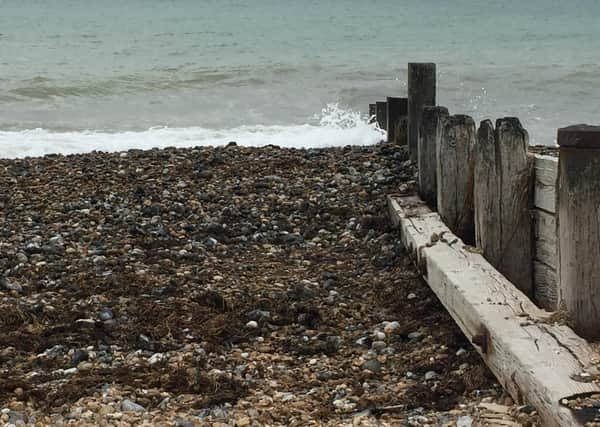Worthing’s timber beach groynes are saved for now


Worthing Borough Council originally sought funding to replace the timber groynes with rocks and would have paid £4.8 million towards the costs with the Environment Agency paying the remainder.
The structures, which protrude from the beach and into the sea, protect and retain beach shingle which slows losses on the shore.
Advertisement
Hide AdAdvertisement
Hide AdBut when the outline business case for the ‘Worthing Coastal Protection Scheme’ was submitted to the Environment Agency for review in 2019, ‘large issues’ were identified. The EA said the project may not be ‘economically viable’ and may not gain funding.
Jim Deen (Lab, Central) previously criticised the original plans and claims that the council ‘wasted money’ on a consultation to replace the sea defences.
He said: “I have been trying to find out how much was actually spent on consultants.”
Mott MacDonald was appointed to prepare the outline business case in 2016.
Advertisement
Hide AdAdvertisement
Hide AdIn November 2019, councillors agreed £500,000 of funding for a groyne design contract.
Mr Deen accepted that the timber groynes ‘had become not as effective as they should be’ but criticised the former replacement plans.
He said: “Everyone accepted that the groynes had become not as effective as they should be.
“The main defence on the beach is actually the pebbles themselves and replacing them is actually a major part of the process. So if you do all those things together, they should be able to hold for ten years.
Advertisement
Hide AdAdvertisement
Hide Ad“Hopefully – in ten years – WBC will have worked up a better idea of what might provide better protection.
“Basically we stuffed it up by putting forward a plan which hadn’t been consulted with anybody.”
Mr Deen claims that placing stone groynes on the seafront would ‘change the character of the area’ and would be ‘uninviting’.
As a result, the council now aims to move forward with a two phase plan which would see the timber groynes maintained and shingle replaced in the first phase.
Advertisement
Hide AdAdvertisement
Hide AdThe second phase would see a new plan submitted for rock defences ‘in the next decade’.
At a meeting of the councils’ joint strategic committee yesterday (September 8), the new plans were outlined.
During the meeting, Carl Walker (Lab, Selden) also raised the amount of money spent so far, saying: “My understanding is Worthing Borough Council spent quite a good deal of money using the consultants and our own staff time drawing up an outline business case and from what I can see the Environment Agency have just completely rewritten the plan.
“What have we learned from this to ensure we don’t find ourselves wasting this kind of money in the future?”
Advertisement
Hide AdAdvertisement
Hide AdCouncil leader Dan Humphreys (Con, Offington) said that allegations of wasting money ‘should be put aside’ but invited officers to outline if any lessons had been learnt following the exercise.
Officers noted that ‘a reasonable amount of money’ had been spent on the original business case but added that the council wanted to replace groynes in Worthing whereas the Environment Agency wanted to look at groynes along ‘the whole coastline’.
Officers explained: “We took a proactive approach to replace the groyne field before it got to a stage where it became totally ineffective.
“This [new plan] will make the groynes last longer until replacing them becomes more viable but it will also put us closer to the chance of them failing.”
Advertisement
Hide AdAdvertisement
Hide AdKevin Jenkins (Con, Gaisford) said the council had ‘spent public money wisely’.
He said: “We are actually a coastal protection authority so the OBC that we put together, the review that we had done by Mott MacDonald, that was a statutory responsibility as a coastal protection authority.
“It’s not something we did lightly or at a whim and actually it has proved beneficial to this council because it has shown that the financial case didn’t stack up for us to do that and enabled us to take those conversations to the Environment Agency.
“We’ve actually spent public money wisely – we’re seeing a scheme over the next two years which will bring forward protection to our seafront, protection importantly to people’s homes in the town centre area, and protection to the businesses.”
Advertisement
Hide AdAdvertisement
Hide AdMr Jenkins said the council needs to ensure the town centre is ‘safe’ through working with the Environment Agency.
As noted by Mr Jenkins, Worthing Borough Council is the Coast Protection Authority, or CPA, for the seafront between Ferring and Lancing.
This means it plays a leading role in protecting the coast from erosion and also works with other coastal authorities to develop ‘shoreline management plans’.
Groynes started to be built to the west of Worthing by 1804 to protect the growing town from erosion. But sea defences remained a difficult topic throughout the century due to the lack of one, unified local authority to manage them.
Blocks of stone were built into the beach at several different points from 1990.